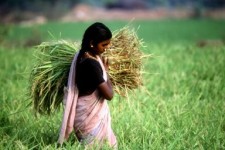Food Production Prioritized in India

One of the world’s hottest economies appears to have cooled a bit. GDP growth in India is estimated to be 6.9%, compared to the 8.4% growth it experienced the past two years. Still, nearly 7% growth is enviable for most of the world, and the country’s agriculture sector continues to perform well.
India continues to prioritize investment in agriculture infrastructure as part of its strategic growth. In March, India Finance Minister Pranab Mukherjee offered parliament his 2012/13 budget, which bolstered the outlay for agriculture 18% to help capitalize on the sectors continued strong growth.
“With agriculture and services continuing to perform well, India’s slowdown can be attributed almost entirely to weak industrial growth,” Mukherjee told parliament during his budget proposal speech. While we do not have aggregate figures for the last quarter of 2011-12, numerous indicators pertaining to this period suggest that the economy is now turning around. There are signs of recovery in coal, fertilizers, cement and electricity sectors. These are core sectors that have an impact on the entire economy. Indian manufacturing appears to be on the cusp of a revival.”
Much of the new investment focuses on key programs and direct investment at the farm level. First, India will more than double its investment into extension services, which are the lynchpin for farmer education and consultation services. It is out of these consultations that crop protection protocols often originate, and more boots on the ground translate to a greater adoption of appropriate crop inputs.
Mukherjee also said the initiative of Bringing Green Revolution to Eastern India (BGREI) has resulted in a significant increase in production and productivity of paddy. States in eastern India have reported additional paddy production of seven million tonnes in Kharif 2011. The resultant success of this intensification project prompted the minister to almost triple the budget for BGREI.
Mukherjee also proposed the following agriculture stimulus:
• to reduce basic customs duty from 7.5% to 2.5% on sugarcane planter, root or tuber crop harvesting machine and rotary tillers and weeders
• to reduce basic customs duty from 7.5 per cent to 5 per cent on specified coffee plantation and processing machinery
• to extend project import benefit to green house and protected cultivation for horticulture and floriculture at concessional basic customs duty of 5%
• to reduce basic customs duty on some water soluble fertilizers and liquid fertilizers, other than urea, from 7.5% to 5% and from 5% to 2.5%
• to extend concessional import duty available for installation of Mechanised Handling Systems and Pallet Racking Systems inmandis or warehouses for horticultural produce
The Government of India is proposing to replace the existing National Agriculture Insurance Scheme (NAIS) by Modified National Agriculture Insurance Scheme (MNAIS) for the benefit of the farmers. A pilot program of the modified scheme was started last year in 24 districts.
As per the new scheme, 90% of the insurance premium will be paid by the Government and 10% by the farmer. The share of the Central and State Government in the subsidy will be in the ratio of 75:25. In case of failed sowing, claim up to 25 per cent is payable. In the modified scheme, the minimum indemnity level will be 70 per cent as compared to 60 per cent in the original NAIS.
Study is going on to shortlist type of crops to be insured, nature of risk to be covered, and recipients to be included. There is proposal to cover lower and medium risk farmers also in the scheme and extending the scheme to localized calamities other than only hailstorms and landslides.
The government is also looking at options of different types of insurance covers to be included under the agriculture insurance schemes. One is the weather index-based crop insurance. Another is a combination of weather-based index and crop yield-based index. For a crop like wheat, heat is a crucial factor and the weightage of weather factor will be more.
The country’s previous investments are already creating more sustainable food production in key growing regions. Grain production in eastern India, for example, is projected to rise 12% this growing season.
Traditionally, yield and production of food grain in the eastern states of India have been low. However, during the current year, food grain production increased by 12% whereas, the growth was only 0.9% in the northern part of India. This has been possible because of increased focus given by BGREI with an initial budget of $80 million was started last year. More than $200 million is allocated for the program this year, largely as a direct investment into intensification of rice, wheat and other small grains.






